Bihar has a rich artistic heritage. Indigenous art forms were heavily influenced by the Mughal Empire and the British Raj. Known as Land of Buddha, Bihar is a place with a fascinating history. Bihar has given birth to many intellectuals whose knowledge has enlightened the world. The people of Bihar follow its ancient traditions till date and the cultural heritage of the place is still very much alive. The festivals, songs and the costumes worn by the people of Bihar is the mirror to its culture and traditions. Today, Bihar is fast developing with the Indian government’s establishment of the Infrastructure Leasing and Financial Services (IL&SF).
TEXTILE OF BIHAR

https://www.exportersindia.com/m-r-handloom-fabrics/tussar-silk-fabric-1314430.htm
Bihar is the largest producer of tassar silk in India. There are three varieties of silk produced and woven in the state: tassar, mulberry and eri silk. Bhagalpur is the paradise for tassar weaving.
Copperish in colour, this is coarse silk generated by the silkworm Antheraea mylitta that thrives on the plants Asan and Arjun. The rearing of this silkworm is conducted naturally on trees in the open, so this is also known as wild silk.
History of Tassar Silk
The origin of the craft is not known but it was observed after the 16th century when the first European merchants came to India and surveyed the craft. Four varieties of tassar fabric were mentioned; these were mainly cotton-mixed fabrics. The weaves and colours were very simple at that time. In Indian tradition, saris of silk are considered very pure, especially saris made up of reeled cocoon, which has not been spun. Another type of fabric known as Mukta, is popular among the Jain community. Here the moth has cut through the cocoon and escaped, leaving the silk filaments as a mass of short fiber, which has to be spun.
Both home furnishings and dress material are made from tussar fabric. Under home furnishings, products are cushion covers, pillow covers, curtains, etc. For apparel, the products are scarves, shawls, saris, dupattas, and running material.
The craftsmen involved in this craft come mainly from communities such as Muslims, Scheduled castes and some local tribes. This craft is the major source of income for the families of nearby villages. Both women and men are involved in tussar silk production.
Designing and Weaving
The first step of tussar weaving involves designing. The master craftsmen select the drawings. The design is mainly variations of weave and color.
Reeling silk:Cocoons are firstly sorted and then the good ones are boiled in water with some amount of soda for 1/2 to 2 hours. For 1280 cocoons, 300gms of soda is used. In this process, the vessel is pressed with a heavy lid, so that the cocoons do not come out. After boiling, the silk strands are unwounded onto bamboo spools.
Throwing:After this process the spools are transferred to skeins. After drying, these skeins are reeled on bobbins to make a thicker, stronger, and multi-threaded yarn. Around 10 skeins are twisted together.
Dyeing:Natural dyes are commonly used for dyeing tussar silk. While the process of dyeing is similar for all colors, mordents are used differently for specific colors. In general, the first step for all dyes is extraction by boiling the dyestuff in water. The solution is strained, and the dye is applied to wet yarn skeins. After some time the skeins are put in mordant solution to fasten the effect of the dye. The last step is to wash the yarn with reetha powder. For black color harer powder is boiled in water for 15-20 minutes. The wet skeins are put in a dye bath for 20 minutes in a separate container.
Kasis stone is used as the mordant. It is put in plain water and sieved. The dyed skeins are put into this kasis solution for 5 minutes. After 20 minutes the skeins are washed in reetha solution. For indigo dye the mordant (alum) is applied before dyeing, and the skeins are kept in an airtight container. After half an hour, the skeins are put into boiling indigo solution. The excess dye is washed out with reetha.
In the weaving operation, lengthwise yarns that run from the back to the front of the loom make the basic structure of the fabric and are called the warp. The crosswise yarn is the filling, also known as weft. Before weaving the warp and weft yarn needs to be spun to the required specifications. Then the yarn is wound onto large spools, which are placed on a rack called a creel. From the creel, the yarn is wound onto the warp beam. This process is known as spooling.
In the weaving process on the loom, the warp beam is mounted at the back and the warp yarns are conveyed to a cylinder called the cloth roll, which is at the front of the loom. Supported on the loom frame between the two cylinders, the warp yarns are ready to be interlaced by the filling or weft yarns, to produce the woven fabric. In the weaving process four steps are fundamental –
Shedding: the operation performed by the harnesses – rectangular frames to which a series of wires, or heddle, are attached. As each warp yarn comes from the beam, it must pass through an opening in the heddle.
Drawing in: the operation of drawing each warp yarn through its appropriate heddle eye. . In the weaving process the heddle frame raises or lowers certain groups of alternate warp yarn by treadles, so that the filling yarns alternate in passing under one group of warp yarns and over another.
Picking: As the harnesses raise the heddles, which in turn raise the warp yarn, the filling yarn is inserted through the shed by the shuttle that contains a bobbin of filling yarn.
This crossing of wefts between the shed of the warp is known as Picking.
Each warp yarn passes through a heddle eyelet and through an opening in another frame that resembles a comb and is called the Reed. With each picking operation, the filling yarn is pushed against the woven fabric. This process is known as Beating.
With each shedding, picking and beating, the newly constructed fabric must be wound on the cloth beam. This is referred to as taking off.
After the fabric is taken off the loom, it is washed with plain water and spread for drying. After drying, water is sprinkled with a spray machine. This spraying should be uniform all over the surface. Then the fabric is folded properly and beaten with a heavy hammer, called kundi. This beating process sets the weave properly. The fabric is now ready for calendaring. This is a mechanically produced finish, achieved by pressing the fabric between a series of two or more rollers to smoothen it and produce a wrinkle free effect.
BIHAR’S BHAGALPURI SILK SARI

https://brijraj.com/blog/bhagalpuri-silk-sarees/
Bhagalpuri sarees are woven and created in a small town called Bhagalpur in Bihar, thus the reference to the name. It is also known as tussar silk sarees given that Bhagalpur town is famous for its special tussar silk. Bhagalpuri silk sarees are an evergreen favourite of every Indian woman who loves draping sarees. One of the finest textured silks, this one is known for its sheen and grandeur which are symbolic of the magnificence that a saree represents.
The Origin
The origin of Bhagalpuri silk sarees can be traced to the city of Bhagalpur in Bihar. Known as “silk city” in popular culture, Bhagalpur has a history of skilled craftsmen who excelled at weaving this unique type of silk. What sets Bhagalpuri silk apart from other varieties of silk is the fact that it is environment-friendly; limited number of silk worms is used during the production of this silk. Due to this very reason, Bhagalpuri silk is also sometimes referred to as “peace silk”.
Bhagalpuri silk sarees are one of the oldest art works in India. What once began as an ordinary task of separating the threads from the silk worms and then spinning on a yarn to weave a brilliantly-textured fabric soon became an area of interest and the source of livelihood for many silk artisans in Bhagalpur. Such was the craftsmanship of these artisans that even the Mughals who ruled India during those days, could not help but appreciate the beauty of the fabric.
Quality Of Bhagalpuri Silk Sarees
So remarkable is the quality of silk produced in Bhagalpur, that it is exported to different parts not only within the country, but even outside India. As a matter of fact, the designers from top fashion hubs of the world such as Paris and Milan have also started using Bhagalpur silk in their creations.
Varieties Available
Speaking of varieties, you will never fall short of choices when it comes to Bhagalpuri silk sarees. These are available in multiple hues and prints, intricate embroidery designs, and patterns. For those who want the best of both worlds, Bhagalpuri silk sarees also come in the form of a blended fabric which is a mix of both cotton and silk. You can find all these varieties and more, at highly reasonable prices on our website. We guarantee you will love the quality and diversity of the fabric.
How To Take Care Of Bhagalpuri Silk Sarees?
Coming down to maintenance, it is always a good idea to get Bhagalpuri silk sarees dry-cleaned. This goes a long way in maintaining the luster and color of the fabric. Always store these sarees in dry and air-tight boxes, wrapped in translucent paper, so that moisture does not cause any damage.
So if royalty and tradition are what you are looking at, then go for Bhagalpuri silk sarees. This elegant and rich fabric is the perfect tribute to the Indian tradition of sarees.
BHAGALPURI CHADAR

Bhagalpuri Chadar is weaved with staple yarn (mix cotton silk); it is also known as Bhagalpuri Andi Chadar. This chadar is very comfortable to use in winter, Summer & Rainy Season. This chadar is Easy to wash, comfortable in use and long lasting. It has soft silky touch.
Features of Bhagalpuri Chadar
1. The most comfortable soft silky full length body cover
sheet Bhagalpuri chadar
2. It ,so soft that even anew born can be wrapped around for the almost comfort
3. The Chadar is weaved from 2 Ply staple yarn and is meant to cover the body
while sleeping.
4. 100% organic yarn
5. The Chadar is highly comfortable in use specially during Summer season,
Rainy season & Light Winter conditions
Types of Bhagalpuri Chadar
Plain Colour Chadar

https://www.amazon.in/Bhagalpuri-Chadar-Comforters-Plain-Color/dp/B07L1Y33XD
These types of Bhagalpuri Chadar comes in Single color mainly as Yellow, Red, Pink, Blue, Navy, Lemon Yellow, Olive Green, Grey, White.
- Patta Chadar
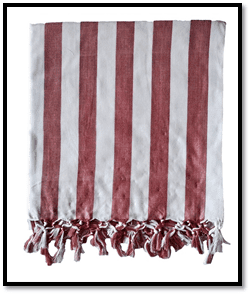
https://www.amazon.in/EthnicAlive-Handloom-Bhagalpuri-Silky-Chadar/dp/B073JGP2GJ
Bhagalpuri Patta Chadar build with combination of two color yarn, in weaving process two or three color yarn used to create striped design. Patta Chadar comes in Red Patta, Pink Patta,
Green Patta, Blue Patta, Red Green Blue Patta etc.
- Double Yarn Chadar
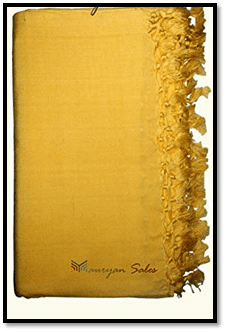
https://www.ideakart.com/products/mauryan-sales-bhagalpuri-cotton-and-silk-blend-comforters-272×135-cm-royal-yellow-324588
Two yarn twisted and weaved in this type of Chadar, Major color is yellow, size is longer than usual.
- Exclusive Chadar
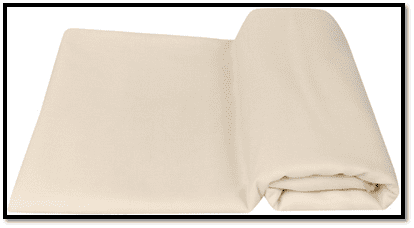
https://m.shopclues.com/hn/bhagalpuri-exclusive-gifting-chada-cream-139402023.html?ref=is_hindi
Premium type of fabric, soft soothe dotted design fabric material. One of the best ethnic gifting options for Grandfather, Grandmother, Grandparents, Friends etc.
- Social Gifting Chadar
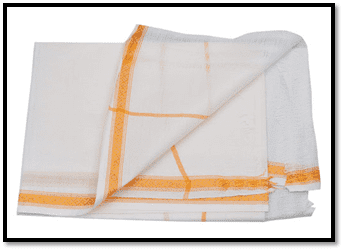
https://www.nutanindiacompany.com/product/bhagalpuri-handloom-puja-social-gifting-towel-white/
Social Event Gifting Shawl, This shawl can be given as present in event, meeting, conferences. All purpose and all season wearing chadar for grandfather, grandmother or all ages people. It is well comfort in use. Design of this chadar is very traditional comes in white color and brown floral strip, Mix Silk material used for weaving of this chadar. Dimension(LxB) : 210×110 Cm. Best For Social Event Gift, School-college programs, Political function, promotional campaign and Corporate gifting.
Washing Instruction For Chadar: Softens after each wash. MACHINE WASH SEPARATELY GENTLE CYCLE HANG DRY. HAND WASH COLD. DO NOT BLEACH.
TRADITIONAL COSTUMES OF BIHAR
Bihar traditional costumes are very ancient. The state has a lot of ancient history and the land of educational institutions in ancient period. The ancient Nalanda university attracted many students from all over the world. So with the long ancient history here we can see the ancient tradition and culture. Here people give more value to the culture and tradition of their society. The hand woven clad and the beautiful designs have been thriving in the land of Bihar. At present, the rural people stick to wear their traditional costumes and jewelry. In Bihar, most of the people live in rural areas and not interested in wearing the newly advent modern costumes. Chhath Puja is the main festival in Bihar and celebrates it in large scale. During the festival period, the people of Bihar wear their traditional dresses and pray to God.
Bihar Traditional Costumes of Men
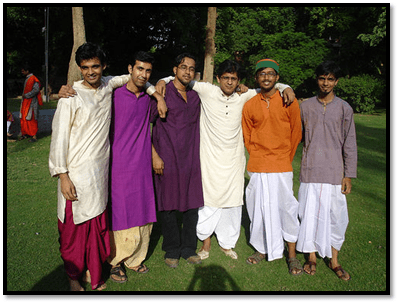
https://indiathedestiny.com/india-society/costumes/bihar-traditional-costumes/
Men in Bihar also wear very attractive apparels during the festival and ceremonies. During the social gatherings, the men wear special costumes which have a lot of dignified colors and appearance. Generally, men wear Churidar, Pyjamas, and Kurtas on the special occasions to impress the gatherers. The Sikhs, Christians and Muslim males spray luxurious fragrance of perfume on their clad. The fragrance also called ‘attar’. Some variety of ‘attar’ also sprayed on an everyday basis. The ornaments for men in Bihar have variety, especially in Patna and Gaya the milkmen wear Kundals, which called ear rings.
Bihar Traditional Costumes of Women
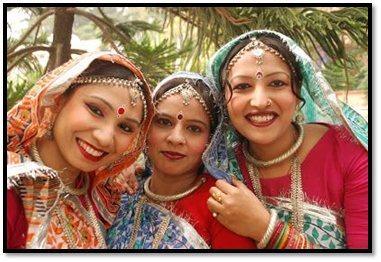
Bihar women are very eager to preserve their folk costumes, which are their traditional costumes. The dress color and dresses designed in their traditional way. Generally, the married women wear the red colored powder which is called Sindoor at parting hair area. The women prefer to wear Tikli which is a beautiful ornament at the forehead. All the rural and urban areas women apply bindi on their foreheads. On the special occasions, women wear eye makeup called Surma. The Surma is very useful as antimony and improves the appeal of the eyes. Bihari rural women traditionally use the Tatoo paintings on their hands and other parts of the body. Applying the Mehendi designs on the hands of the women is a cultural activity in Bihar.
WEDDING CUSTOMES
Bihari Bride
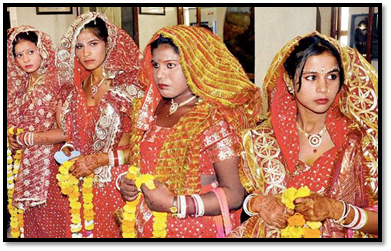
https://www.indiatoday.in/mail-today/story/bihar-brides-say-no-to-dowry-seekers-insensitive-remarks-319044-2016-04-21
Every state has its own color that they consider to be auspicious. For Bihar, the color is red and yellow. Often on auspicious events red and yellow have always been a favourite and most chosen amongst the Biharis. Therefore, the weddings taking place in this state has more of red and yellow than any other color.
The bride usually wears red, golden or yellow colored lehengas. On the day of engagement, the dress is subtle than wedding hence the colors are a softer version of red and yellow.
There is a unique custom in Bihar that the dresses worn by the bride at the time of Haldi and Mehandi are given to the barber.
Logically, it is because the clothes are soiled with Henna and turmeric paste post the ceremony so it is of no use to the bride. It is said that a bride should have new and clean clothes at the time of her wedding. This ritual is slowly fading away since nowadays the brides of Bihar also prefer to wear basic clothes during such ceremonies to cut on the cost.
Bihari Grooms

Just like the bride, the groom has a lot of options to choose from for his wedding rituals. In older times, a typical Bihar groom would be seen wearing dhoti and kurta. The groom today usually wears kurta pajama or a formal western suit. Usually, a formal western suit is chosen for engagement while kurta pajama is chosen for the wedding day. For kanyadaan and vidaai of the bride, the groom changes to traditional clothes if he is wearing the formal western suit for the wedding. Some cities and towns of Bihar still witness the groom wearing the traditional dhoti kurta.
CHATT POOJA COSTUMES
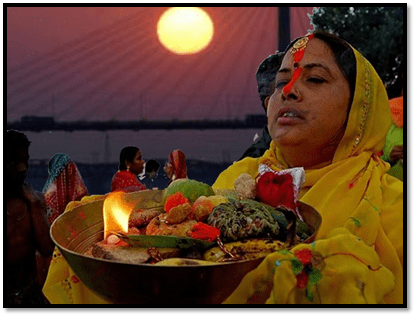
https://navbharattimes.indiatimes.com/astro/others/according-to-vishnu-puran-why-sunrise-and-sunset-seeing-is-inauspicious-22087/
On the day of Chhath, people wear traditional dress preferably in saffron color. Women wear saree and men wear Kurta and Dhoti and avoid using leather in any form in their clothing. Women also carry a deep streak of vermilion from nose to the end of hair split.
TRIBES OF BIHAR
Bihar is home to a multitude of tribes that constitute the major chunk of social and culture map of Bihar.
BATHUDI

Bathudi Tribe is among the most important tribes left in Bihar. They are the most colorful and artistic of all tribes in the state. There homes which are ordinary mud thatched houses are made extraordinary with some exquisite multi colored flowery designs. The dressing style is also different from other with men usually preferring coarse dhoti of cotton and women choosing saris of different colors. Silver ornament are also a must for Bathudi women. You will find most of the women sporting floral tattoos on their forehead or arms, which is a ritual of the tribe. The Bathudi people call this tattooing as Khada. The people of Bathudi tribe are mostly all Hindus and worship Hindu Gods and Goddesses. The common language spoken by Bathudi people is Bihari.
BINJHIA
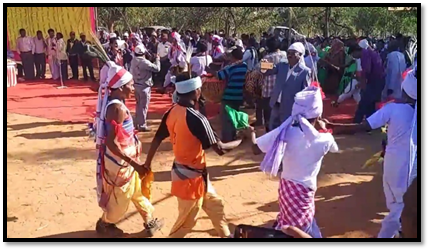
https://www.youtube.com/watch?v=EaUs5ZXHHT0
The Binjhia tribe is known for its rich culture and heritage. You will find this tribe mostly residing near forests and hilly areas. Anthropologists consider Binjhia tribe to be the most advanced of all. It is evident from the their homes which are built using tiles, wood, bamboo and are nicely and spaciously designed. Even the social structure is nicely laid out. A normal family consists of father, mother and their unmarried children. Father is the head of the family. Monogamy is more prevalent with widow remarriage being allowed. Binjhia tribe men wear dhoti, kurta, and ganji where as women dress up in sari, saya and blouse. Women also prefer wearing ornaments while going out
BIRJIA

https://www.kaahon.com/folk/a-new-history-since-migration-of-a-small-ethnic-tribe-birjia/
Birjia is one of the largest tribes in Bihar today. Earlier they were mainly resident of hilly areas but because of difficulties in agriculture, they moved down to plains. Most of the Birjia people are farmers and only few of them indulged in occupations like gathering, hunting, fishing, basketry, and working as daily labors. There social structure is also similar to others with father being the head of the family and the main decision maker. Most of the Birjia tribe people practice Hinduism and worship Hindu Gods and Goddesses. Birjia folks also worship ancestral spirits for peace and prosperity.
CHIK BARAIK
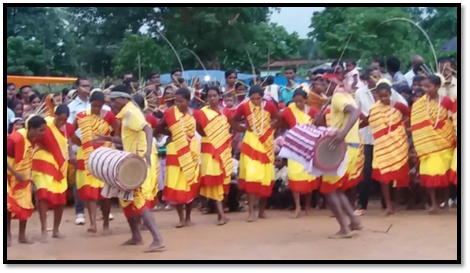
Chik Baraik tribe is mainly found in the rural parts of Bihar. The most peculiar feature of this tribe is that you will not find any village or premises dedicated to them alone. They are considered very friendly and share space with other tribes. Chik Baraik is famous as a tribe of artists. They are involved n making cotton threads and cotton clothes. They also work as weavers, bird trappers, farmers and daily labours. The languages spoken by Chik Baraik people include Mundari, Sadani and Hindi.
ORNAMENTS WORN BY BIHARI’S
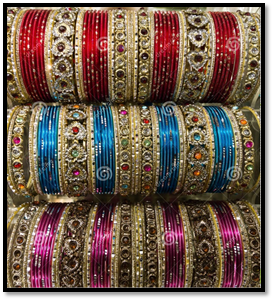

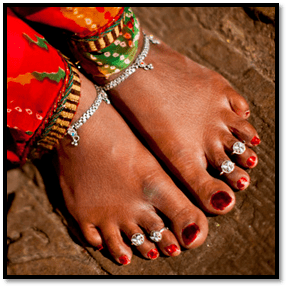
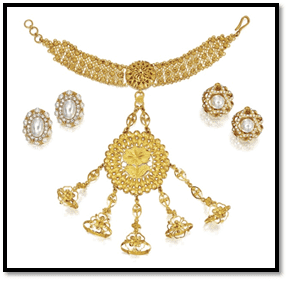
Bihar has a rich tradition of jewellery-making. Tribals wear a variety of jewellery made from natural materials as also from bell-metal and brass, especially as anklets and bracelets. Delicate ear rings worked in filigree with various designs are worn by the Santhal women. Small bells or ghungroos are held together by delicate chains and worn by the women. Even today the tribals use wild grass twisted into necklaces as ornaments. Bright feathers are used, both by the men and the women, to decorate their hair and turbans. Munda girls wear necklaces of beads, silver, and brass.
A lot of the tribal jewellery has designs of flowers, berries, and leaves. The jewellery worn by the peasants of Bihar takes its designs and motifs from nature and uses floral patterns. The paunchi, which is a bracelet made of hundreds of small silver or brass jasmine buds strung together, is a faithful replica of jasmine buds. Women also wear a kardhani, for the waist and chudha for the wrists. Tikuli is ornamental work on fine glass done with wafer-thin tabaque (gold or silver leaves) and worn by women on their foreheads.
The jewellery worn by the Muslim women is quite different from that worn by the Hindu women. The silver jewellery imitates the kundan work made for the Muslim wearers and the hanging jhumkis are more fragile in appearance than those worn by the Hindu peasant women. The border areas have both an Indian and Nepalese influence. Some interesting jewellery forms are associated with the local superstitions and religious customs. Small amulet boxes are made to ward off the evil eye and are worn by the people of all communities.
EMBROIDERY OF BIHAR
KASIDA
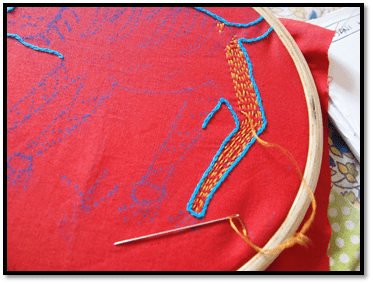
https://www.swadesi.com/news/kasida-art-form-of-bihar/
The Kasida artform is one of the oldest art forms that are still in trend. The art form involves geometrical designs that are embroidered on clothes and looks similar to the Kasuti Embroidery of Mysore. Although there are many kinds of stitching it involves jhankhana stitch.
The Kasida art is not unique to Bihar but it’s also famous in Kashmir. But, unlike the kasida of Kashmir, Bihar’s kasida is famous for embroidery work on fabrics of day to day use. However, the folk involved in kashida work of Kashmir are men and that of Bihar is women. The embroidery is done with gold and silver metallic threads beads, silk, and sequins on satin or velvet having the motifs of birds, leaf and many other. The stitch is done on personal garments followed by filling-in using long and short satin stitches. Materials used are a mostly Bright colored material with contrasting white, yellow, or green thread. If the base material is white, a contrasting color like blue-black or steel blue threads is used. Also, the motifs are geometrical in shape.
This art form is particularly famous in Mithila region where young girls from various caste. The main theme for them is the religious and folk with many other motifs like elephants and fishes, with lines, stripes, leaves, and flowers as borders.
This popular art form has been a gem for Bihar. Although not too popular and mostly taken over by other popular embroidery artforms, the artisans have kept it alive and fresh. The time ahead for them and the related artform is always going to take upward stride from here.
SUJNI

https://www.patnabeats.com/this-art-form-from-bihar-was-awarded-by-unesco-this-year/
The uniqueness in the embroidery of Bihar lies in the field of textile as the craftsmen are adept at sujni work. The chain-stitch embroidery has flourished in Monghyr District of Bihar. The artisans of this state show dexterity in creating items using a very indigenous style of embroidery work which is called ‘kantha’ embroidery. This embroidery work is simple in its style and appearance. This simple stitch involves tracing simple running stitches with short gaps. The artisans create floral, animal and bird motifs on both cotton and silk that have immense popularity in the local market. The tradition of practicing Sujni kanthas craft originated from the Rajput women and since then the artisans of Bihar have been creating articles using this embroidery work. The local people create small quilt for newly-born babies where patches of different coloured cloth are sewn together and then covered in designs. The local people prefer to create beautiful embroidery of gods and goddesses that are hung on walls. Sujni embroidery is done on a fabric that is implemented with fine muslin. The base fabric is generally red or white. The outlines of the main motifs are highlighted with thick chain stitch. The inner spaces of the motifs are filled with threads of vibrant colours. Other motifs are filled with red colour or the colour of the base fabric.
Process & Technique
The most important requirement is to use easily available raw material as the base fabric. The process begins with tracing down the designs on the base fabric using tracing wheel and tracing sheet. Then artisans start drawing background by fine running stitch. And finally black or brown threads are used for outlining the motifs and colorful threads are used to fill in colors in the motifs. Materials required for Sujani kantha stitch include a needle, frame, scissors, threads of various colours, inch tape, tracing sheet, tracing wheel, pencil, rubber, blue chalk and kerosene.
Difference between Kantha Stitch & Sujani Embroidery
This style of embroidery is similar to the Kantha stitch of West Bengal. Difference in use of colors, themes and motifs differentiate these two embroideries from each other. One of the prime difference is that in Kantha embroidery, artisans can stitch in any direction of the fabric, while in Sujani embroidery should always be done in straight lines. Going deep into the intricacies of Sujani style stitch, one will find that this embroidery is done only on cream colored fabric with stitched motifs outlined by black colored thread while multiple colored threads are used to fill in colors.
KHATWA
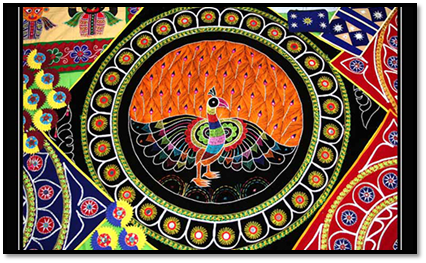
https://strandofsilk.com/journey-map/bihar/applique/history
Khatwa is the name given to appliqué works in Bihar. Khatwa is about designing by cutting of one fabric and stitching the pieces to another fabric. Khatwa is mainly used to create designer tents, canopies, shamianas and much more. Making of such tents involves work by both men and women. While cutting of clothes is done by men, women use their expertise in stitching part. Khatwa is also used in designing women garments as well. This is where the real talent of Bihar people is seen in the work. The designs created are more sharp, intricate and highly appealing. Most of the garments shop sell these highly artistic clothes.People in some villages of Bihar are involved only in art works and it is their main source of income.
ART AND CRAFT OF BIHAR
The state of Bihar is rich in its arts and crafts, which is quite evident from the fact that it is home to some of India’s first paintings, including the famous Madhubani paintings and the miniature paintings done on paper and leaves, wall decorations, patchwork, applique work and local handicrafts.
BAMBOO AND CANE CRAFTS OF BIHAR

https://www.umsas.org.in/en/bihar-arts-crafts/bamboo-cane-craft/
The bamboo and cane crafts of Bihar have a rich historical past that is amalgamated with the preferences of the modern urban people. As Bihar is affluent in the tradition of the powerful dynasties like Magadha Majanapadas, Mauryan Empire and Gupta Empire, the artisans had received encouragement from them. With the introduction of modern technologies the bamboo and cane craft of Bihar has flourished. As the time precedes the tradition of the past and the style of the modern age have developed the cult of the bamboo and cane crafts of Bihar.
The bamboo and cane crafts of Bihar have unique features that carry intrinsic beauties and great creativeness offered by the local artisans. Initiated in the prehistoric age, the bamboo and cane crafts of Bihar comprise utility items like baskets, household wares, woven mats, furniture and cane products like cane furniture and other decorative objects.
MADHUBANI (MITHILA) PAINTING
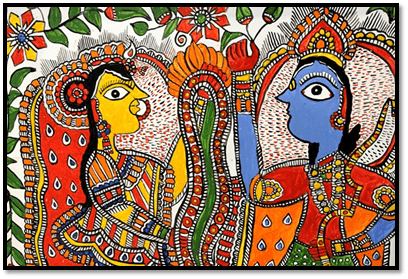
https://www.craftsvilla.com/blog/history-of-madhubani-art-paintings-will-leave-you-in-awe/
Madhubani painting, also called Mithila Painting, is a traditional folk art of Bihar which has succeeded in creating a place globally. Madhubani painting has been done traditionally by the women of villages around the present town of Madhubani and other areas of Mithila region of Bihar. The painting was traditionally done on freshly plastered mud wall of huts, but now it is also done on cloth, hand-made paper and canvas. The colors used are derived from plants. The exact time when Mithila art originated is not known. It is believed that during the time of the Ramayana, when King Janak ordered his kingdom to decorate the town for the wedding of his daughter, Sita, to Lord Rama. The ancient tradition of elaborate wall paintings or Bhitti-Chitra in Bihar played a major role in the emergence of this new art form. The original inspiration for Madhubani art emerged out of women’s craving for religiousness and an intense desire to be one with God. With the belief that painting something divine would achieve that desire, women began to paint pictures of gods and goddesses with an interpretation so divine that captured the hearts of many.
MANJUSHA ART (ANGIKA ART)

https://www.remek.in/blogs/crafts-of-india/manjusha-art-a-saga-of-love-and-sacrifice
Manjusa art is believed to be the only art form in the history of art form in India which has a sequential representation of the story and is displayed in a series. This is also called a scroll painting. Manjusa art is a folk art of Bhagalpur, Bihar, and has been dated back to the 7th century. The name Manjusa is also associated with an elaborate story, a goddess and also a festival celebrated in Bhagalpur. The Sanskrit word “Manjusa” means a box and Manjusas are temple shaped boxes, made of bamboo, Jute-Straw and Paper inside which the devotees keep their ceremonial materials. These boxes are however illustrated with paintings that tell a tale. The tale is that of Bihula who saved her husband from the deity’s wrath and a snake-bite and also of Bishahari or Mansa, the snake goddess known for her anger when displeased but also her fierce protectiveness when propitiated.
METAL CRAFT
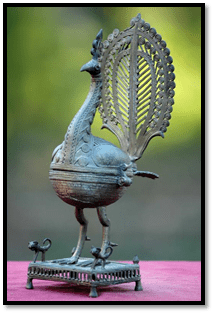
https://www.umsas.org.in/en/bihar-arts-crafts/metal-craft/
Bell metal is a mixture of copper and tin. Wax and wood which are essentially needed for these forest based metal crafts, are naturally available in abundance in tribal areas of Bihar. The craft received patronage from the Royal families, who used to pay the artisans to make idols.
Brass or bell metal craft items are prepared by melting the metal using a lost wax technique. All individuals and group artisans work around their houses or at a common place. Raw materials required for bell metal art are cluster of bees wax, brass metal and fire wood.
PATNA KALAM
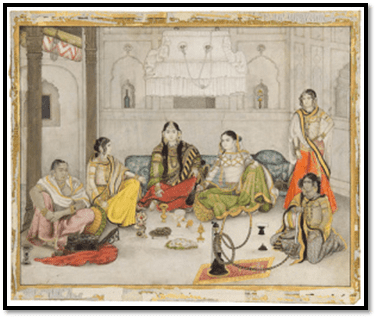
https://accessunderline.wordpress.com/2014/04/21/patna-kalam-its-glory-and-saga-abid-hadi/
Patna School of Painting or Patna Qalaam (Patna Kalam) or Company Painting is a style of Indian Painting, which existed in Bihar, India in the 18th and 19th centuries. Patna Kalam caught the connoisseurs eye for its clear stylistic difference and unusual use of water colours. For the first time, there was a rich coherence between realism and visual perspective. This style combined elements of the Mughal and British styles of paintings so well, that it was called the Feringhee Kalam (the White man’s art). The paintings were done on surfaces as diverse as paper, mica and even ivory diskettes, that were used as brooches. That it was the world’s first independent school of painting which dealt exclusively with the commoner and his lifestyle also helped Patna Kalam paintings gain in popularity. The subjects of these paintings had always been the common man and his mundane routines. It’s basically a miniature form of painting which has, because of its unique style and form, occupied separate shelves at art galleries in London and museums in Prague.
PAPIER MACHE
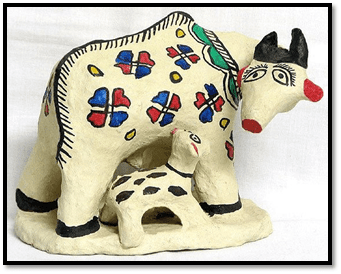
https://in.pinterest.com/pin/481674122628530594/
First, the dry paper is soaked in water for about one week. After it has fragmented in the water, it is crushed in khal musal, or beaten with a hammer, to make it into a paste. Multani mitti is soaked in water for at least 24 hours. Then, the paper, multani mitti, methi powder and adhesive are mixed together to form various shapes and sizes. Whole process is done by hand and at the end the shapes are dried and painted to give it a perfect look. At present paper mache is used in production of utilitarian accessories and households. There is a huge collection of paper mache crafts in the museum of Upendra Maharathi Shilp Anusandhan Sansthan. The institute also gives training on paper mache to the students and artisans.
POTTERY & CERAMICS

Pottery and ceramics have been an important part of human culture for thousands of years. From prehistoric storage jars to tiles on the space shuttles, pottery and ceramics have played a key role in innumerable human endeavors.
In art history, ceramics and ceramic art mean art objects such as figures, tiles, and tableware made from clay and other raw materials by the process of pottery. Some ceramic products are regarded as fine art, while others are regarded as decorative, industrial or applied art objects, or as artifacts in archaeology. They may be made by one individual or in a factory where a group of people design, make and decorate the ware. Decorative ceramics are sometimes called “art pottery”.
STONE CARVINGS (PATTHARKATI)

https://www.umsas.org.in/en/bihar-arts-crafts/stone-carvings/
The tradition of the stone craft of Bihar dates back to the ancient eras and it had reached its zenith during the Mauryan period as the dynasty was characterised by its craftsmanship. The Pattharkatti region of Atri in Gaya is one of the major centres of stone craft in Bihar. Other centres are located in Nalanda, and Patna. The stone craft of Bihar demonstrates some huge statues of the great sage, Buddha that are basically found in the neighbouring places of Gaya. Including these, various Stupas and monasteries stand as the great examples of the excellent artistic quality of the artisans of Bihar. Among the most popular stone carvings, the Ashoka pillar at Sarnath is the beautiful piece that exhibit marvellous art of stone craft of Bihar. Black stone artisans of Gaya in Bihar are also well acclaimed for their creation of the Vishnapad temple in black stone in Gaya.
The official website is https://www.bihartourism.gov.in/
TIKULI ART

https://www.umsas.org.in/en/bihar-arts-crafts/tikuli-art/
Having its origin in Patna city, the craft, which is believed to be around 800 years old, involved melting glass, adding traced pattern in natural colours and thereafter embellishing it with gold foil to create the “tikuli” or “bindi”, which is worn by married Indian women on their forehead.
OFFICIAL TOURISM GOVERNMENT WEBSITE

https://commons.wikimedia.org/wiki/File:Blissfiul_Bihar_Tourism_Logo.jpg
Bihar State Tourism Development Corporation is a body of the Government of Bihar responsible for the development of tourism in the Indian state of Bihar. It was established in 1980 to develop tourism in the state.
The official website is https://www.bihartourism.gov.in/


